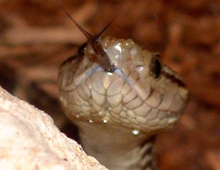Description: The terrestrial Central American fer-de-lance, also known as the Terciopelo and Barba amarilla in Spanish, is one of the largest, most dangerous venomous snakes in the Yucatán Peninsula. The large head is V-shaped like a lance and quite distinguishable from the neck. The eyes are rather large with a vertical pupil. A deep heat- detecting pit is located between each nostril and eye. The head is darker in color on top and a light creamish-yellow on the underside. Their color and pattern varies, but dorsal base color is normally shades of brown and dark gray; ventral side is often a mottled cream or pale gray. Light colored stripes outline the dark diamond shapes on the upper body and sides.
Size: Lengths of 9.8 feet (3 m) have been reported, however, they are usually four to six feet (1.2-1.8 m) long. Females are considerably larger than males, weighing more than 10 pounds (4.5 kg) and have bigger heads and longer fangs.
Behavior: Fer-de-lances are easily agitated and can move very fast. They are primarily solitary and nocturnal; these well-camouflaged snakes tend to bask and rest during the day unless threatened. They are less active during cool and/or dry weather. Fer-de-lances cause the majority of snake bites within its range.
Diet: Adults feed predominantly on birds, small mammals, particularly rats and mice; juveniles consume small frogs, lizards and centipedes. They are ambush predators.
Senses: Their highly-sensitive heat-detecting pit organs are used for finding food and detecting danger.
Reproduction: Breeding is believed to take place during the rainy season when food is plentiful. However, because their geographical range is so large, there is much variation in time and duration of reproduction seasons. Fertilization is internal and Bothrops aspers are live-bearing. After a gestation period of six to eight months, offspring are born; litter size is dependent on size of the mother snake.
Habitat/range: Fer-de-lances inhabit tropical rain, evergreen and cloud forests, edges of savannas and even in some of the drier and less humid deciduous forests. They are found from Ecuador to Venezuela in the northwestern coast of South America, in Trinidad and north into Mexico. They are widespread in most of the Yucatán Peninsula.
Status: Has not been assessed for the IUCN Red List.



